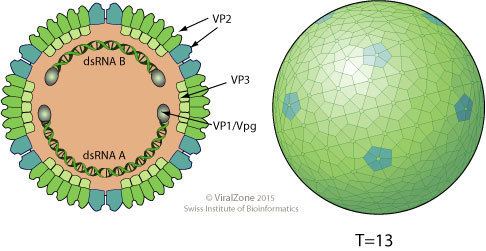Group Group III (dsRNA) | Rank Family | |
 | ||
Similar Cystovirus, Totiviridae, Partitiviridae, Chrysovirus, Asfarviridae | ||
Birnaviridae friday
Birnaviridae is a family of viruses. Salmonid fish, young sexually immature chickens, and insects serve as natural hosts. There are currently six species in this family, divided among 4 genera. Diseases associated with this family include: IPNV: infectious pancreatic necrosis in salmonid fish, causes significant losses to the aquaculture industry. chronic infection in adult, and acute viral disease in young salmonid fish.
Contents
- Birnaviridae friday
- Medical vocabulary what does birnaviridae mean
- Birnaviridae proteins
- Structure
- Life Cycle
- Taxonomy
- References
Medical vocabulary what does birnaviridae mean
Birnaviridae proteins
The Birnaviridae genome encodes several proteins:
Birnaviridae RNA-directed RNA polymerase (VP1), which lacks the highly conserved Gly-Asp-Asp (GDD) sequence, a component of the proposed catalytic site of this enzyme family that exists in the conserved motif VI of the palm domain of other RNA-directed RNA polymerases.
The large RNA segment, segment A, of birnaviruses codes for a polyprotein (N-VP2-VP4-VP3-C) that is processed into the major structural proteins of the virion: VP2, VP3 (a minor structural component of the virus), and into the putative protease VP4. VP4 protein is involved in generating VP2 and VP3. recombinant VP3 is more immunogenic than recombinant VP2.
Infectious pancreatic necrosis virus (IPNV), a birnavirus, is an important pathogen in fish farms. Analyses of viral proteins showed that VP2 is the major structural and immunogenic polypeptide of the virus. All neutralizing monoclonal antibodies are specific to VP2 and bind to continuous or discontinuous epitopes. The variable domain of VP2 and the 20 adjacent amino acids of the conserved C-terminal are probably the most important in inducing an immune response for the protection of animals.
Non structural protein VP5 is found in RNA segment A. The function of this small viral protein is unknown. It is believed to be involved in influencing apoptosis, but studies are not completely concurring. The protein can not be found in the virion.
Structure
Viruses in Birnaviridae are non-enveloped, with icosahedral and Single-shelled geometries, and T=13 symmetry. The diameter is around 70 nm. Genomes are linear and segmented, around 15.2.3-3kb in length. The genome codes for 5 to 6 proteins.
Life Cycle
Viral replication is cytoplasmic. Entry into the host cell is achieved by penetration into the host cell. Replication follows the double-stranded RNA virus replication model. Double-stranded rna virus transcription is the method of transcription. Salmonid fish, young sexually immature chickens, and insects serve as the natural host. Transmission routes are contact.
Taxonomy
Group: dsRNA
